Graph Convolutional-Optimization Framework for Carbon-Conscious Grid Management
Abstract
1. Introduction
2. Materials and Methods
2.1. Generalized Problem Formulation
2.1.1. Constraints [49]
- AC Power Balance (for AC buses)
- DC Power Balance (for DC buses with converters):
- Generation Limits:
- Ramping Limits (for conventional generators):
- Battery Dynamics
- Demand Response
- Emissions Cap
- Chance Constraint
- Voltage Stability:
2.1.2. Uncertainty Modeling
- Wind:
- Solar:
- Load:
2.2. Graph Convolutional Network (GCN) Integration
- Graph Structure:
- -
- The microgrid forms a graph
- -
- Features:
- -
- Adjacency matrix (A) reflects power flow connectivity
- GCN Model:
- -
- Layer propagation:
- -
- Outputs predictions .
- Training Loss:
2.3. Hybrid Optimization
- -
- Objective (Z)
- -
- Constraints: As above, with
2.3.1. Network Graph
2.3.2. GCN Initialization
- Set X with generation and demand profiles:
- Compute
2.4. Optimization Algorithms Employed
2.4.1. Interior-Point Method with GCN-Enhanced Initialization for Power System Optimization
| Algorithm 1: Interior-Point Method with GCN-Enhanced Initialization for Power System Optimization | |
| Network graph | |
| Output | |
| 1. | GCN initialization |
| 2. | Initialize: Set , barrier parameter |
| 3. | Barrier Formulation: Introduce a logarithmic barrier to handle inequalities: where > 0 is the barrier parameter, ensuring (interior feasibility). |
| 4. | Lagrangian Construction: Incorporate equality constraints via Lagrange multipliers: With and as multipliers for inequalities and equalities, respectively. |
| 5. | While convergence is not met
where is the Hessian of the Lagrangian, approximated or computed analytically
Ensuring bounds via projection if necessary
|
| 6. | End While |
| 7. | If satisfied:
|
| 8. | Else
|
| 9. | End |
2.4.2. Genetic Algorithm with GCN-Enhanced Population for Power System Optimization
| Algorithm 2: Genetic Algorithm with GCN-Enhanced Population for Power System Optimization |
| Network graph |
| Output |
where
|
2.4.3. Particle Swarm Optimization with GCN-Enhanced Swarm for Power System Optimization
- Step-by-Step Procedure:
| Algorithm 3: Particle Swarm Optimization with GCN-Enhanced Swarm for Power System Optimization |
| Network graph |
|
2.5. Case Study
2.5.1. Assumptions
- -
- The ramping limits only on conventional (40% of max power). Renewables (wind and solar) have no ramp limits or emissions (except minimal for wind at 0.1 p.u./MVA). All generators can charge/discharge like batteries, which seems to model integrated storage at generator buses.
- -
- Uncertainty is modeled as Gaussian noise: 3% standard deviation for demand, 10% for wind, 5% for solar.
- -
- Batteries are modeled at each generator bus with uniform capacity (, scaled), charging/discharging efficiencies (95% both ways), and SoC bounds (0.2–1 p.u.).
2.5.2. Grid Setup
- Topology:
- -
- AC line impedances: ;
- -
- DC line resistance: ;
- -
- Thermal limits: 175 MW (AC lines 1–20), 400 MW (AC lines 21–28, DC lines).
- Generators:
- -
- (conventional max power, p.u.): [6, 5, 4, 3, 2.5];
- -
- (wind max, p.u.): [4, 3.5, 3];
- -
- (solar max, p.u.): [3, 3];
- Emission factors: 0.7–0.9 kg CO2/MWh (conventional), 0–0.1 kg CO2/MWh (renewables) [18].
- Load:
- -
- -
- (p.u.): [1.95, 1.8, 1.6, 1.4, 1.2, 1, 0.9, 0.8, 0.71, 0.71];
- -
- (p.u.): → [0.0585, 0.054, 0.048, 0.042, 0.036, 0.03, 0.027, 0.024, 0.0213, 0.0213].
- Battery Storage:
- -
- : 0.6374 p.u. (63.74 MW);
- -
- : 0.95;
- -
- : 0.95.
- Stochastic Scenario Parameters
- -
- (p.u.): [4, 3.5, 3] (reshaped);
- -
- (std dev): → [0.4, 0.35, 0.3];
- -
- : [3, 3];
- -
- : → [0.15, 0.15].
- AC-DC Conversion: 97% converter efficiency for DC-coupled solar and wind units.
- Voltage Constraints: in [0.95, 1.05] p.u.
- Emissions Cap: CO2-equivalent, enforced via chance constraints (), the Total Carbon emission before optimization is 373.8240 kg CO2.
- Optimization-Related Inputs
- -
- (chance constraint risk): 0.05;
- -
- () ≈ 1.6449 (for 95% confidence);
- -
- Initial guesses (): Based on for , 0.8 for SoC, etc.;
- -
- Bounds: lb = 0 or specific mins, .
- Scenarios: 1000 initial scenarios reduced to 100 via k-medoids clustering (Figure 2).
2.5.3. Simulation Environment
3. Results
Simulation Results
4. Discussion
5. Conclusions
Author Contributions
Funding
Institutional Review Board Statement
Informed Consent Statement
Data Availability Statement
Conflicts of Interest
Abbreviations
| Decision Variables: | |
| Energy generated by generator g at time t (in per-unit, p.u.). | |
| Battery storage level for generator g at time t (p.u.). | |
| Demand response adjustment for load l at time t (p.u.). | |
| Slack variable for power balance at time t (p.u.). | |
| Parameters: | |
| : | Maximum generation capacity for generator g (p.u.). |
| : | Battery storage capacity per generator (p.u.). |
| : | Base demand for load l (p.u.). |
| Temporal load profile factor at time (t). | |
| : | Emission rate per unit of energy at time (t) (kg CO2/MW). |
| Carbon emissions cap (p.u.). | |
| and : | Battery charging and discharging efficiencies. |
| Maximum battery charge/discharge rate (p.u.). | |
| Initial battery state (p.u.). | |
| Base power for unit conversion (MW). | |
| and | Scenario-specific generation and load factors. |
| the number of generators | |
| the number of loads | |
| penalty coefficient. | |
| the weight adjusting emission-cost trade-off at time (t) | |
| σ: | mean |
| μ | standard deviation |
| : | the emission rate (kg CO2/MWh) |
| Penalty coefficient. The expectation accounts for stochastic scenarios. | |
| active power flow | |
| the voltage magnitude | |
| , BijB_{ij} | the conductance and susceptance |
| the voltage angle difference | |
| the DC line resistance | |
| , | battery charging/discharging |
| the adjusted demand | |
| Represents conversion losses (e.g., κ = 0.05\kappa = 0.05 ). |
References
- Garïp, S.; Özdemïr, Ş.; Altin, N. Power System Reliability Assessment—A Review on Analysis and Evaluation Methods. J. Energy Syst. 2022, 6, 401–419. [Google Scholar] [CrossRef]
- Sarmiento-Vintimilla, J.C.; Larruskain, D.M.; Torres, E.; Abarrategi, O. Assessment of the operational flexibility of virtual power plants to facilitate the integration of distributed energy resources and decision-making under uncertainty. Int. J. Electr. Power Energy Syst. 2024, 155, 109611. [Google Scholar] [CrossRef]
- Zhou, A.; Yang, M.; Fang, X.; Zhang, Y. Addressing Wind Power Forecast Errors in Day-Ahead Pricing with Energy Storage Systems: A Distributionally Robust Joint Chance-Constrained Approach. IEEE Trans. Sustain. Energy 2024, 15, 1754–1767. [Google Scholar] [CrossRef]
- Nemati, N.; Kasani, A.A. Analysis of Wind Power Integration in Electricity Markets LMP Pricing. arXiv 2024, arXiv:2410.11139. [Google Scholar] [CrossRef]
- Zhang, Q.; Shukla, A.; Xie, L. Efficient Scenario Generation for Chance-Constrained Economic Dispatch Considering Ambient Wind Conditions. IEEE Trans. Power Syst. 2024, 39, 5969–5980. [Google Scholar] [CrossRef]
- Sun, X.; Bao, M.; Ding, Y.; Hui, H.; Song, Y.; Zheng, C.; Gao, X. Modeling and evaluation of probabilistic carbon emission flow for power systems considering load and renewable energy uncertainties. Energy 2024, 296, 130768. [Google Scholar] [CrossRef]
- Bhatraj, A.; Salomons, E.; Housh, M. An optimization model for simultaneous design and operation of renewable energy microgrids integrated with water supply systems. Appl. Energy 2024, 361, 122879. [Google Scholar] [CrossRef]
- Zhang, H.; Huang, J.; Zhang, X.; Wong, C.-N. Uncertainty quantification of aerosol jet 3D printing process using non-intrusive polynomial chaos and stochastic collocation. Adv. Eng. Inform. 2025, 65, 103175. [Google Scholar] [CrossRef]
- Springer, M.; Deline, C.; Muller, M.; Perry, K.; Deceglie, M.; Jordan, D.; White, R. Advancing our Understanding of System Availability through the PV Fleet Performance Data Initiative. In Proceedings of the 2024 IEEE 52nd Photovoltaic Specialist Conference (PVSC), Seattle, WA, USA, 9–14 June 2024; IEEE: New York, NY, USA, 2024; pp. 326–328. [Google Scholar] [CrossRef]
- Liu, X.; Wang, W. Deep Time Series Forecasting Models: A Comprehensive Survey. Mathematics 2024, 12, 1504. [Google Scholar] [CrossRef]
- Gaebler, J.D.; Goel, S. A simple, statistically robust test of discrimination. Proc. Natl. Acad. Sci. USA 2025, 122, 10. [Google Scholar] [CrossRef]
- Pourdaryaei, A.; Mohammadi, M.; Mubarak, H.; Abdellatif, A.; Karimi, M.; Gryazina, E.; Terzija, V. A new framework for electricity price forecasting via multi-head self-attention and CNN-based techniques in the competitive electricity market. Expert Syst. Appl. 2024, 235, 121207. [Google Scholar] [CrossRef]
- Onyutha, C. Randomized block quasi-Monte Carlo sampling for generalized likelihood uncertainty estimation. Hydrol. Res. 2024, 55, 319–335. [Google Scholar] [CrossRef]
- Syed, W.U.; Elfadel, I.M. Uncertainty Quantification Using Polynomial-Chaos Expansion. In Tapered Beams in MEMS; Springer International Publishing: Cham, Switzerland, 2024; pp. 189–215. [Google Scholar] [CrossRef]
- El-Khozondar, H.J.; El-Khozondar, R.J.; Nassar, Y.F.; El-Batta, F. Technical-economical-environmental assessment of grid-connected hybrid renewable energy power system for Gaza Strip-palestine. Eng. Sci. Technol. Int. J. 2025, 69, 102120. [Google Scholar] [CrossRef]
- Islam, S.S.; Ghosh, P.; Faruque, O.; Islam, R.; Hossain, A.; Alam, S.; Sheikh, R.I. Optimizing Short-Term Photovoltaic Power Forecasting: A Novel Approach with Gaussian Process Regression and Bayesian Hyperparameter Tuning. Processes 2024, 12, 546. [Google Scholar] [CrossRef]
- Bin, L.; Abbas, R.; Shahzad, M.; Safdar, N. Probabilistic Load Flow Analysis Using Nonparametric Distribution. Sustainability 2023, 16, 240. [Google Scholar] [CrossRef]
- Barja-Martinez, S.; Aragüés-Peñalba, M.; Munné-Collado, Í.; Lloret-Gallego, P.; Bullich-Massagué, E.; Villafafila-Robles, R. Artificial intelligence techniques for enabling Big Data services in distribution networks: A review. Renew. Sustain. Energy Rev. 2021, 150, 111459. [Google Scholar] [CrossRef]
- Du, S.; Li, D.; Xin, Y.; Cao, Q. Production Simulation Method of High Proportion New Energy Power System Based on Interval Probability. In Proceedings of the 2024 11th International Forum on Electrical Engineering and Automation (IFEEA), Shenzhen, China, 22–24 November 2024; pp. 426–432. [Google Scholar] [CrossRef]
- Wang, Y.; Sun, W. A Two-Stage Robust Pricing Strategy for Electric Vehicle Aggregators Considering Dual Uncertainty in Electricity Demand and Real-Time Electricity Prices. Sustainability 2024, 16, 3593. [Google Scholar] [CrossRef]
- Quizhpe, K.; Arévalo, P.; Ochoa-Correa, D.; Villa-Ávila, E. Optimizing Microgrid Planning for Renewable Integration in Power Systems: A Comprehensive Review. Electronics 2024, 13, 3620. [Google Scholar] [CrossRef]
- Nassar, Y.F.; El-Khozondar, H.J.; Elnaggar, M.; El-Batta, F.F.; El-Khozondar, R.J.; Alsadi, S.Y. Renewable energy potential in the State of Palestine: Proposals for sustainability. Renew. Energy Focus 2024, 49, 100576. [Google Scholar] [CrossRef]
- Jurčević, J.; Pavić, I.; Čović, N.; Dolinar, D.; Zoričić, D. Estimation of Internal Rate of Return for Battery Storage Systems with Parallel Revenue Streams: Cycle-Cost vs. Multi-Objective Optimisation Approach. Energies 2022, 15, 5859. [Google Scholar] [CrossRef]
- Pecina, E.; Sprčić, D.M.; Lacković, I.D. Qualitative Analysis of Enterprise Risk Management Systems in the Largest European Electric Power Companies. Energies 2022, 15, 5328. [Google Scholar] [CrossRef]
- Zoričić, D.; Knežević, G.; Miletić, M.; Dolinar, D.; Sprčić, D.M. Integrated Risk Analysis of Aggregators: Policy Implications for the Development of the Competitive Aggregator Industry. Energies 2022, 15, 5076. [Google Scholar] [CrossRef]
- Božiček, A.; Franc, B.; Filipović-Grčić, B. Early Warning Weather Hazard System for Power System Control. Energies 2022, 15, 2085. [Google Scholar] [CrossRef]
- Šadek, S.; Grgić, D.; Allison, C.; Perez-Ferragut, M. Uncertainty Study of the In-Vessel Phase of a Severe Accident in a Pressurized Water Reactor. Energies 2022, 15, 1842. [Google Scholar] [CrossRef]
- Tokarski, S.; Magdziarczyk, M.; Smoliński, A. Risk Management Scenarios for Investment Program Delays in the Polish Power Industry. Energies 2021, 14, 5210. [Google Scholar] [CrossRef]
- Ogunniran, O.; Babatunde, O.; Akintayo, B.; Adisa, K.; Ighravwe, D.; Ogbemhe, J.; Olanrewaju, O.A. Risk-Based Optimization of Renewable Energy Investment Portfolios: A Multi-Stage Stochastic Approach to Address Uncertainty. Appl. Sci. 2025, 15, 2346. [Google Scholar] [CrossRef]
- Naghibi, A.F.; Akbari, E.; Shahmoradi, S.; Pirouzi, S.; Shahbazi, A. Stochastic economic sizing and placement of renewable integrated energy system with combined hydrogen and power technology in the active distribution network. Sci. Rep. 2024, 14, 28354. [Google Scholar] [CrossRef]
- Aziz, A.; Yousaf, M.Z.; Renhai, F.; Khan, W.; Siddique, U.; Ahmad, M.; Abbas, M.; Bajaj, M.; Zaitsev, I. Advanced AI-driven techniques for fault and transient analysis in high-voltage power systems. Sci. Rep. 2025, 15, 5592. [Google Scholar] [CrossRef]
- Elomiya, A.; Křupka, J.; Jovčić, S.; Simic, V.; Švadlenka, L.; Pamucar, D. A hybrid suitability mapping model integrating GIS, machine learning, and multi-criteria decision analytics for optimizing service quality of electric vehicle charging stations. Sustain. Cities Soc. 2024, 106, 105397. [Google Scholar] [CrossRef]
- Hu, H.; Yu, S.S.; Trinh, H. A Review of Uncertainties in Power Systems—Modeling, Impact, and Mitigation. Designs 2024, 8, 10. [Google Scholar] [CrossRef]
- Ebeed, M.; Aleem, S.H.E.A. Overview of uncertainties in modern power systems: Uncertainty models and methods. In Uncertainties in Modern Power Systems; Elsevier: Amsterdam, The Netherlands, 2021; pp. 1–34. [Google Scholar] [CrossRef]
- Arora, P.; Ceferino, L. Probabilistic and machine learning methods for uncertainty quantification in power outage prediction due to extreme events. Nat. Hazards Earth Syst. Sci. 2023, 23, 1665–1683. [Google Scholar] [CrossRef]
- Verdecchia, R.; Lago, P.; de Vries, C. The future of sustainable digital infrastructures: A landscape of solutions, adoption factors, impediments, open problems, and scenarios. Sustain. Comput. Informatics Syst. 2022, 35, 100767. [Google Scholar] [CrossRef]
- Orji, U.; Güven, Ç.; Stowell, D. Enhanced Load Forecasting with GAT-LSTM: Leveraging Grid and Temporal Features. arXiv 2025, arXiv:2502.08376. [Google Scholar]
- Muller, D.C.; Selvanathan, S.P.; Cuce, E.; Kumarasamy, S. Hybrid solar, wind, and energy storage system for a sustainable campus: A simulation study. Sci. Technol. Energy Transit. 2023, 78, 13. [Google Scholar] [CrossRef]
- Hassan, Q.; Algburi, S.; Sameen, A.Z.; Salman, H.M.; Jaszczur, M. A review of hybrid renewable energy systems: Solar and wind-powered solutions: Challenges, opportunities, and policy implications. Results Eng. 2023, 20, 101621. [Google Scholar] [CrossRef]
- Bashir, T.; Wang, H.; Tahir, M.; Zhang, Y. Wind and solar power forecasting based on hybrid CNN-ABiLSTM, CNN-transformer-MLP models. Renew. Energy 2025, 239, 122055. [Google Scholar] [CrossRef]
- Hasnat, A.; Asadi, S.; Alemazkoor, N. A graph attention network framework for generalized-horizon multi-plant solar power generation forecasting using heterogeneous data. Renew. Energy 2025, 243, 122520. [Google Scholar] [CrossRef]
- Zhang, Q.; Bao, C.; Han, P. Towards intelligent energy management in hybrid ships: Predicting and optimizing solar, wind, and diesel energy. Ocean Eng. 2025, 339, 122092. [Google Scholar] [CrossRef]
- Dong, Y.; Ai, X.; Chen, Z.; Yin, Y.; Zhang, X.; Yue, Y. Enhanced dynamic and static graph attention network for power time series prediction. In Proceedings of the International Conference on Optics, Electronics, and Communication Engineering (OECE 2024), Wuhan, China, 26–28 July 2024; Yue, Y., Ed.; SPIE: Nuremberg, Germany, 2024; p. 112. [Google Scholar] [CrossRef]
- Liu, J.; Fu, Y. Renewable energy forecasting: A self-supervised learning-based transformer variant. Energy 2023, 284, 128730. [Google Scholar] [CrossRef]
- Hung, Y. A review of Monte Carlo and quasi-Monte Carlo sampling techniques. WIREs Comput. Stat. 2024, 16, 1. [Google Scholar] [CrossRef]
- Lindsay, M.; Emimal, M. Fuzzy logic-based approach for optimal allocation of distributed generation in a restructured power system. Int. J. Appl. Power Eng. (IJAPE) 2024, 13, 123–129. [Google Scholar] [CrossRef]
- Sobti, R.; Anjaneyulu, M.; Satyanarayana, K.; Bobba, P.; Perveen, A.; Debnath, S. Hybrid Renewable Energy Microgrids: A Genetic Algorithm Approach to System Design. MATEC Web Conf. 2024, 392, 01182. [Google Scholar] [CrossRef]
- Hou, Z.; Liu, J. Enhancing Smart Grid Sustainability: Using Advanced Hybrid Machine Learning Techniques While Considering Multiple Influencing Factors for Imputing Missing Electric Load Data. Sustainability 2024, 16, 8092. [Google Scholar] [CrossRef]
- Cheong, H.; Ebrahimi, M.; Duggan, T. Optimal Design of Continuum Robots with Reachability Constraints. IEEE Robot. Autom. Lett. 2021, 6, 3902–3909. [Google Scholar] [CrossRef]
- Lee, D.; Han, C.; Kang, S.; Jang, G. Chance-constrained optimization for active distribution networks with virtual power lines. Electr. Power Syst. Res. 2023, 221, 109449. [Google Scholar] [CrossRef]
- Roald, L.; Andersson, G. Chance-Constrained AC Optimal Power Flow: Reformulations and Efficient Algorithms. IEEE Trans. Power Syst. 2017, 33, 2906–2918. [Google Scholar] [CrossRef]
- Porras, Á.; Domínguez, C.; Morales, J.M.; Pineda, S. Tight and Compact Sample Average Approximation for Joint Chance-Constrained Problems with Applications to Optimal Power Flow. INFORMS J. Comput. 2023, 35, 1454–1469. [Google Scholar] [CrossRef]
- Zhang, J.; Cheng, C.; Yu, S.; Su, H. Chance-constrained co-optimization for day-ahead generation and reserve scheduling of cascade hydropower–variable renewable energy hybrid systems. Appl. Energy 2022, 324, 119732. [Google Scholar] [CrossRef]
- Zhang, D.; Ma, Y.; Liu, J.; Jiang, S.; Chen, Y.; Wang, L.; Zhang, Y.; Li, M. Stochastic Optimization Method for Energy Storage System Configuration Considering Self-Regulation of the State of Charge. Sustainability 2022, 14, 553. [Google Scholar] [CrossRef]
- Goteti, N.S.; Hittinger, E.; Williams, E. Stochastic Capacity Expansion Model Accounting for Uncertainties in Fuel Prices, Renewable Generation, and Demand. Energies 2025, 18, 1283. [Google Scholar] [CrossRef]
- Rojek, I.; Mikołajewski, D.; Galas, K.; Piszcz, A. Advanced Deep Learning Algorithms for Energy Optimization of Smart Cities. Energies 2025, 18, 407. [Google Scholar] [CrossRef]
- Aljohani, A. Deep learning-based optimization of energy utilization in IoT-enabled smart cities: A pathway to sustainable development. Energy Rep. 2024, 12, 2946–2957. [Google Scholar] [CrossRef]
- Ngo, Q.-H.; Nguyen, B.L.H.; Vu, T.V.; Ngo, T. State Estimation for Power Distribution System Using Graph Neural Networks. In Proceedings of the 2023 IEEE Electric Ship Technologies Symposium (ESTS), Alexandria, VA, USA, 1–4 August 2023; IEEE: New York, NY, USA, 2023; pp. 441–446. [Google Scholar] [CrossRef]
- Feng, D.; Li, D.; Zhou, Y.; Wang, W. MLFGCN: Short-term residential load forecasting via graph attention temporal convolution network. Front. Neurorobotics 2024, 18, 1461403. [Google Scholar] [CrossRef] [PubMed]
- Shan, S.; Sreeram, V.; Li, C.; Dou, W.; Wang, K.; Zhang, K.; Wei, H. Investigation of Transformer-based models performance on solar irradiance forecast: Empirical results and analysis. J. Renew. Sustain. Energy 2025, 17, 3. [Google Scholar] [CrossRef]
- Neumann, O.; Turowski, M.; Mikut, R.; Hagenmeyer, V.; Ludwig, N. Using weather data in energy time series forecasting: The benefit of input data transformations. Energy Inform. 2023, 6, 44. [Google Scholar] [CrossRef]
- Bodini, N.; Optis, M.; Redfern, S.; Rosencrans, D.; Rybchuk, A.; Lundquist, J.K.; Pronk, V.; Castagneri, S.; Purkayastha, A.; Draxl, C.; et al. The 2023 National Offshore Wind data set (NOW-23). Earth Syst. Sci. Data 2024, 16, 1965–2006. [Google Scholar] [CrossRef]
- Ramasamy, V. Solar Photovoltaic System and Energy Storage Cost Benchmarks with Minimum Sustainable Price Analysis Data File. NREL Data Catalog; National Renewable Energy Laboratory: Golden, CO, USA, 2025. Available online: https://research-hub.nrel.gov/en/persons/vignesh-ramasamy (accessed on 15 July 2025).
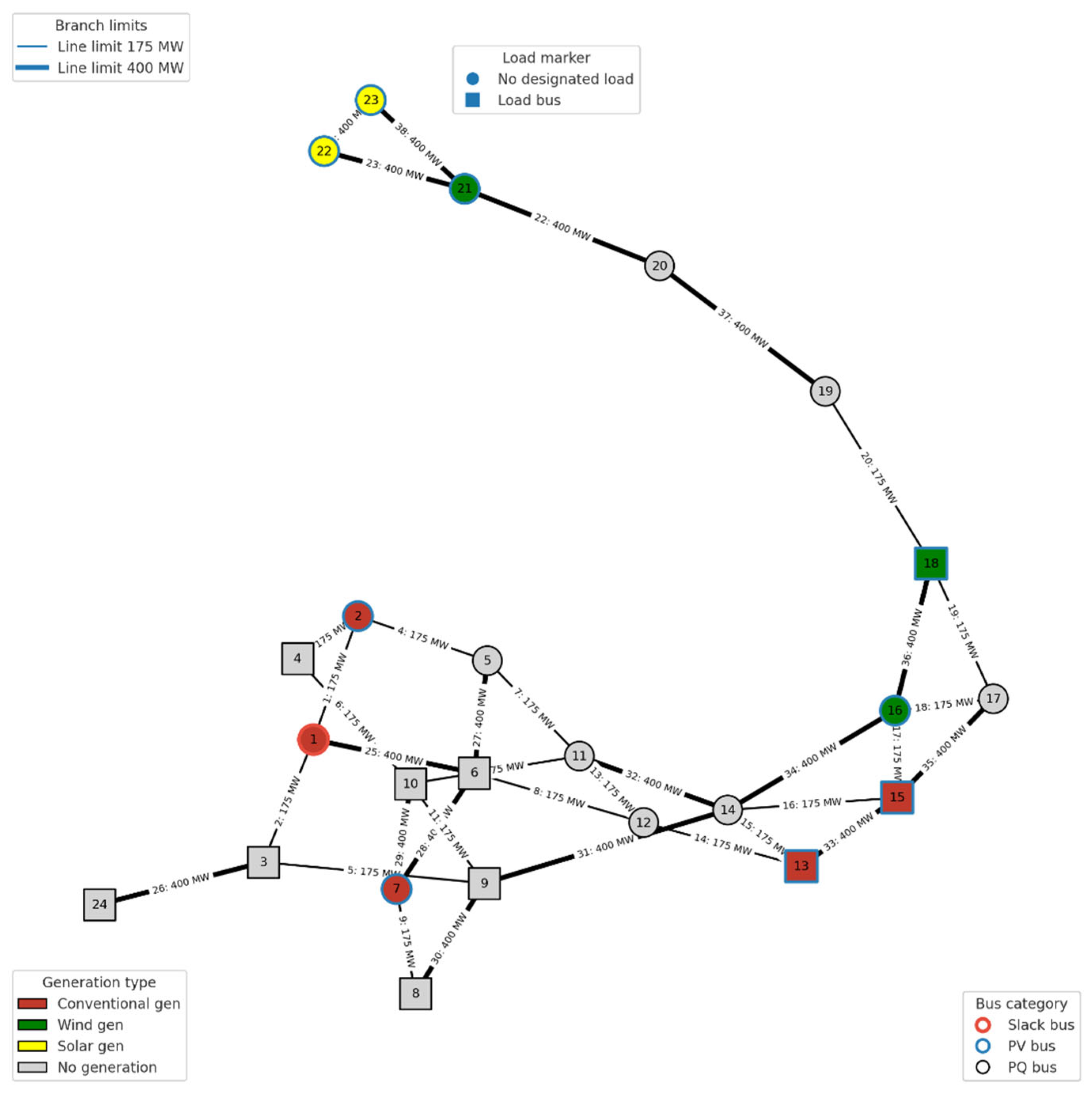
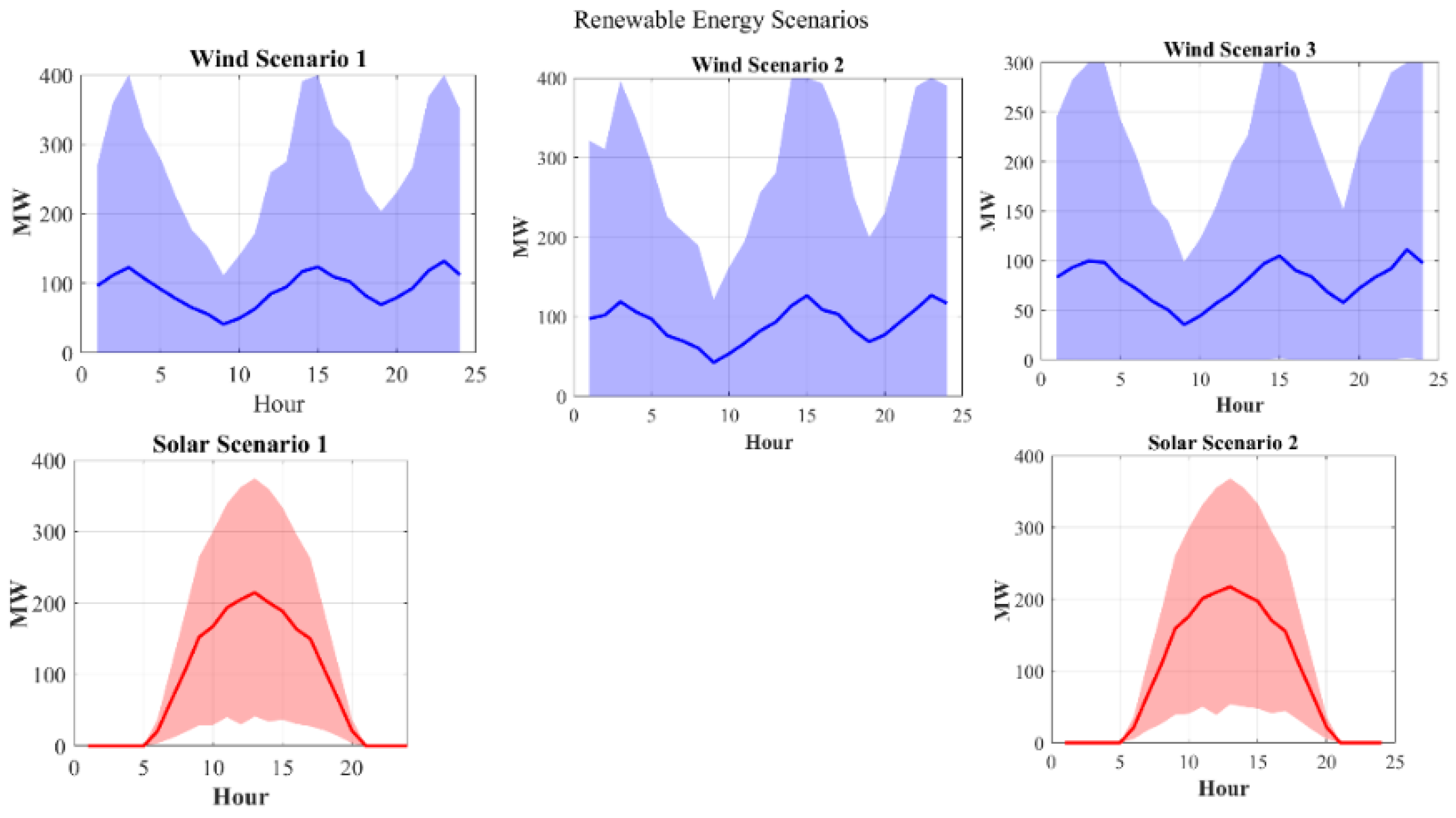
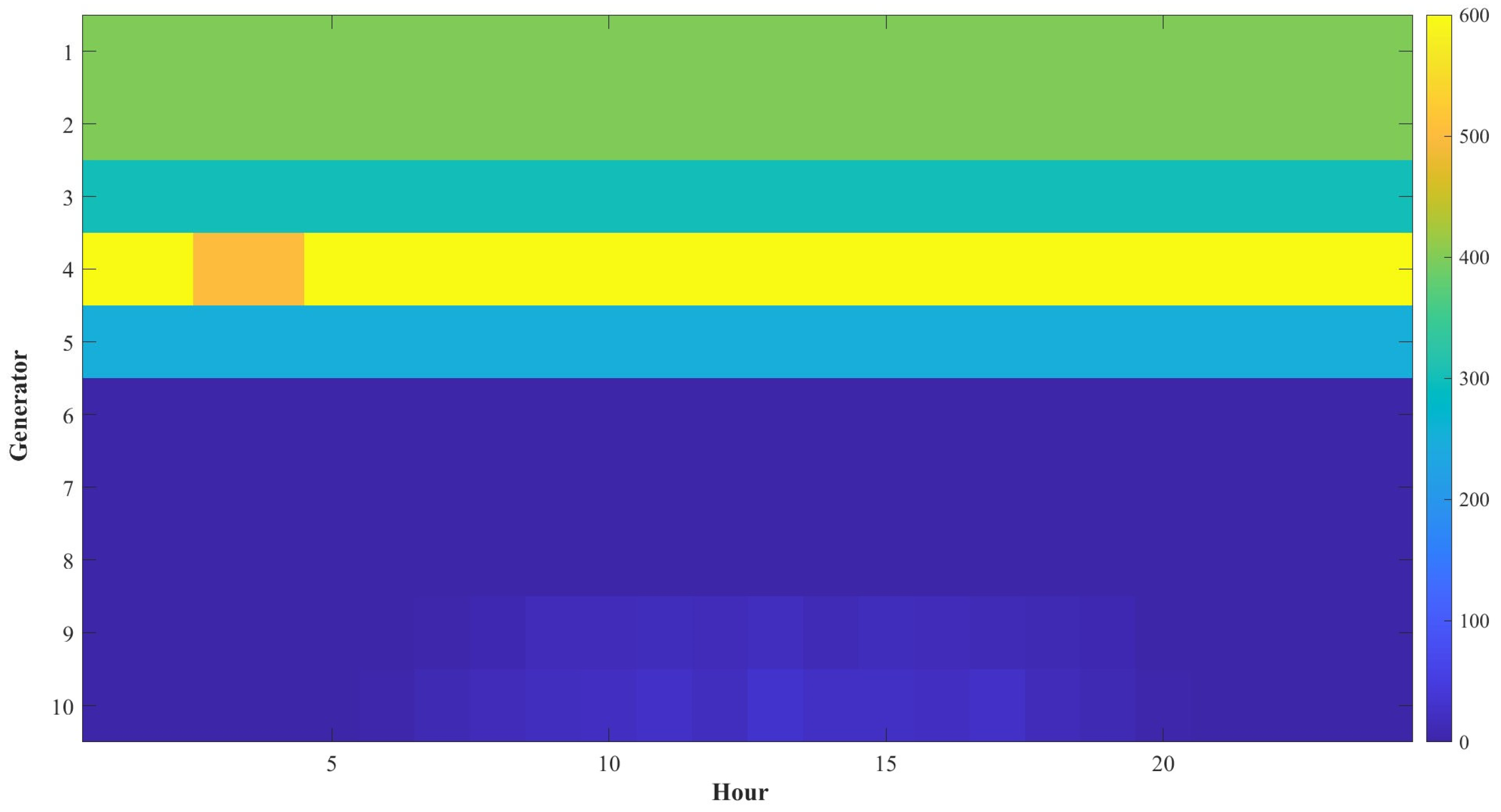
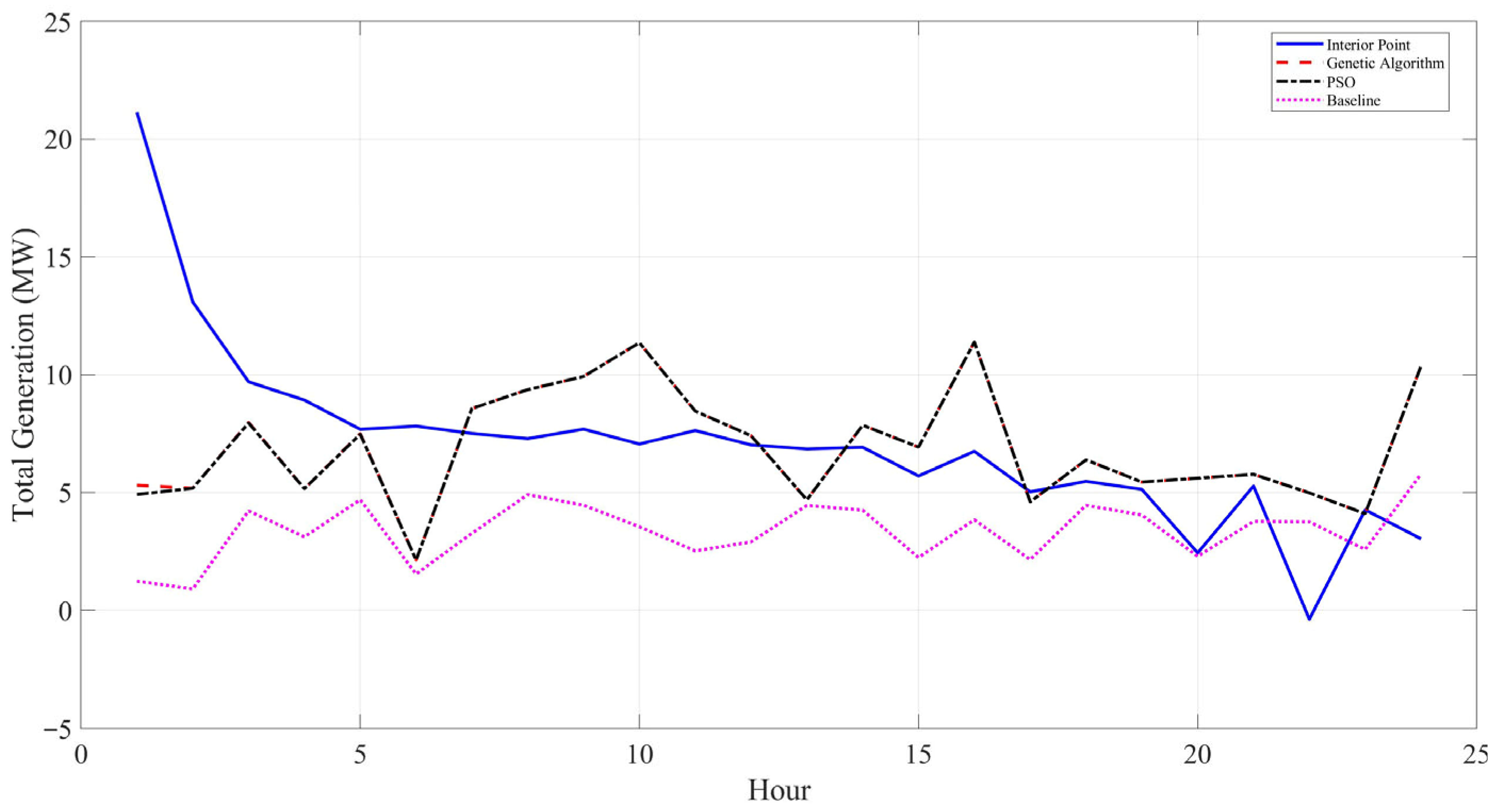
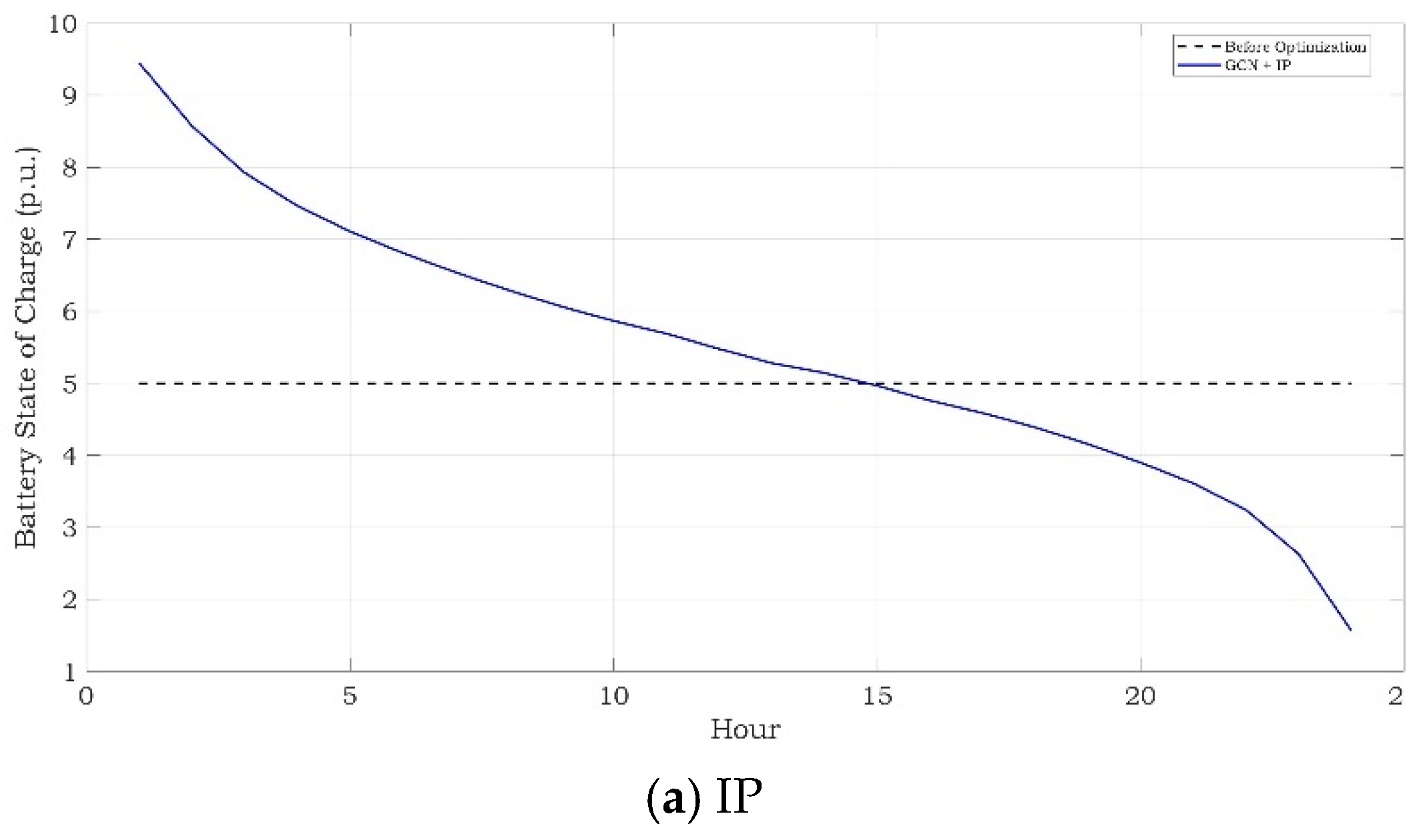
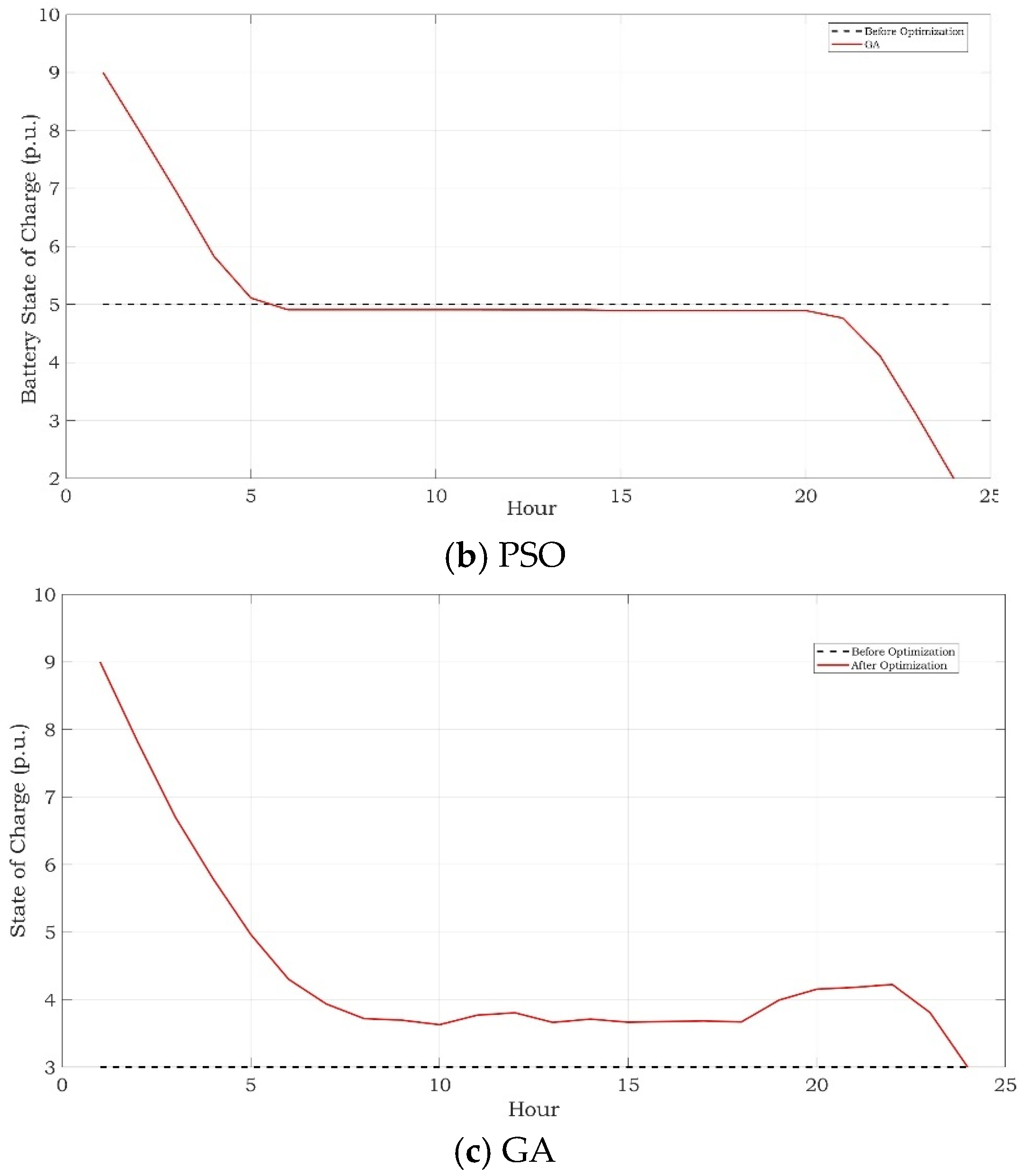
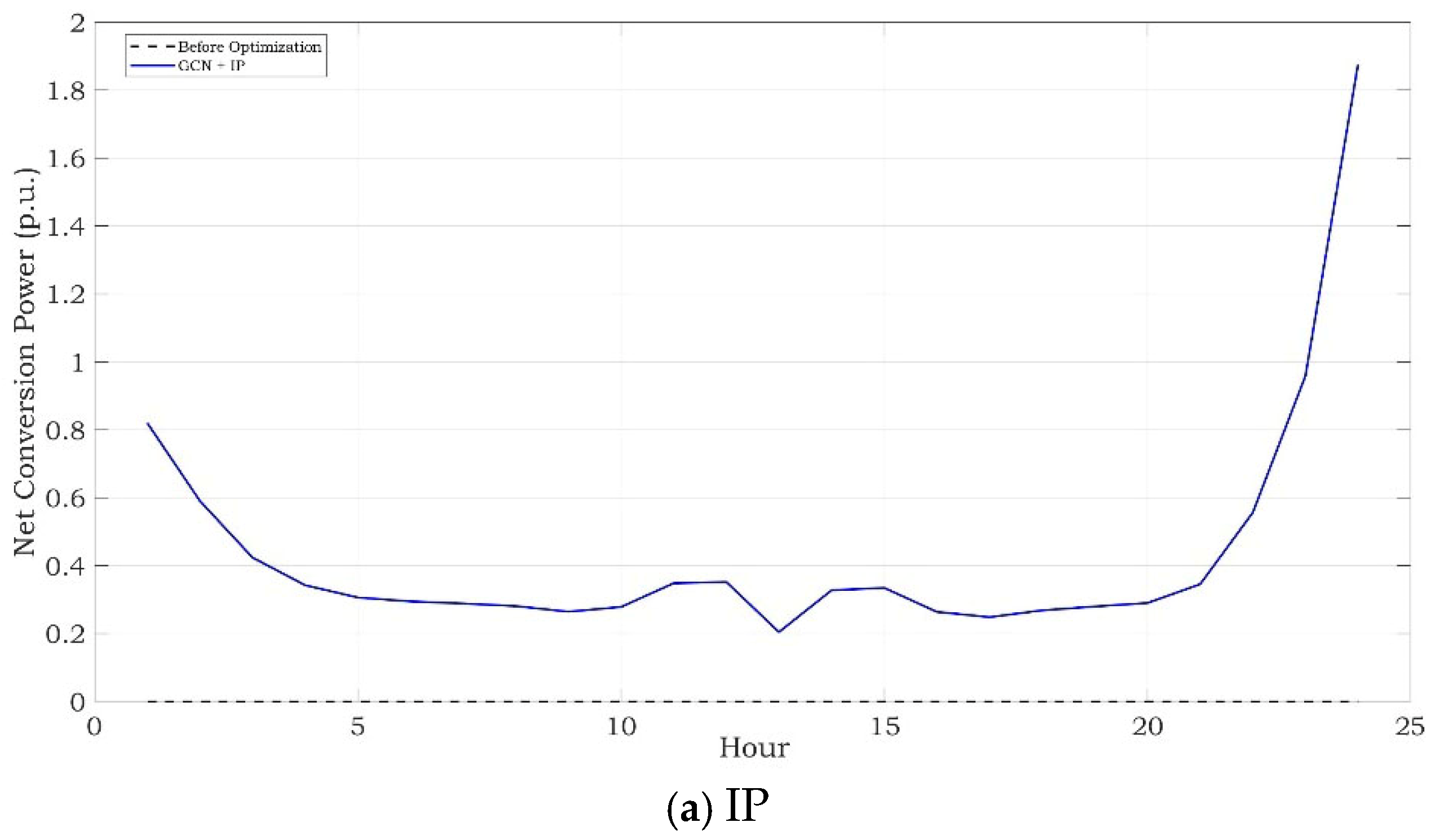
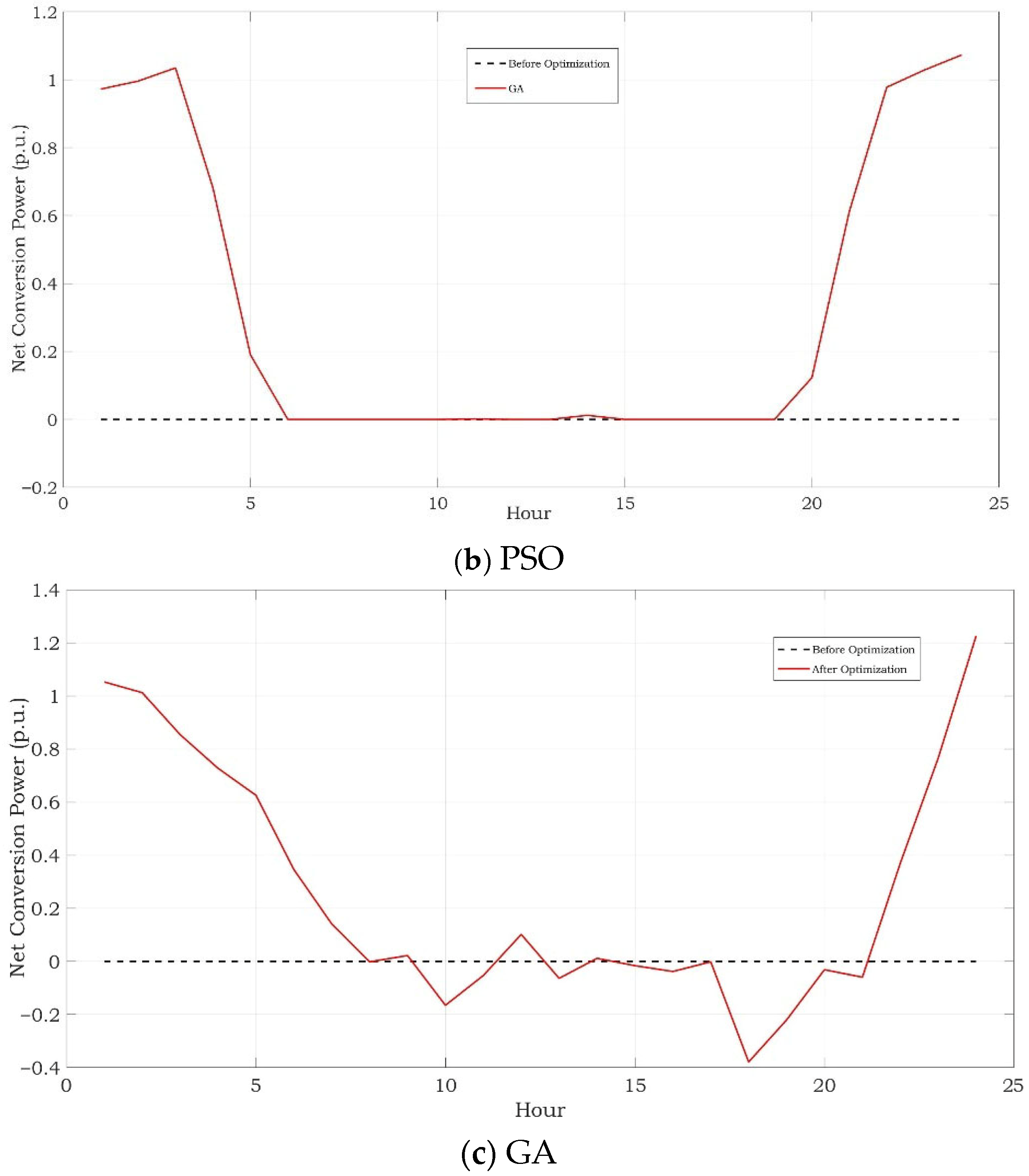
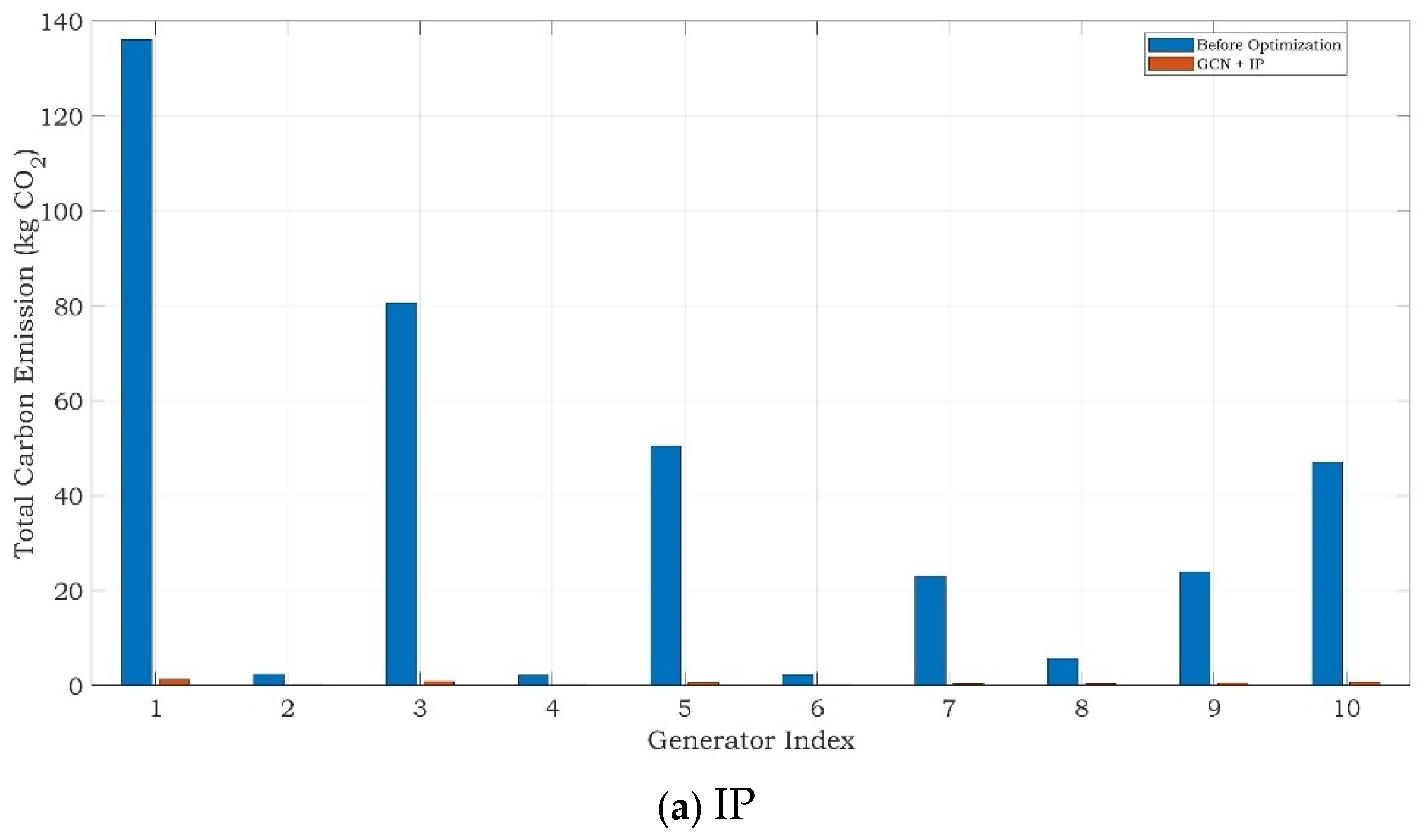
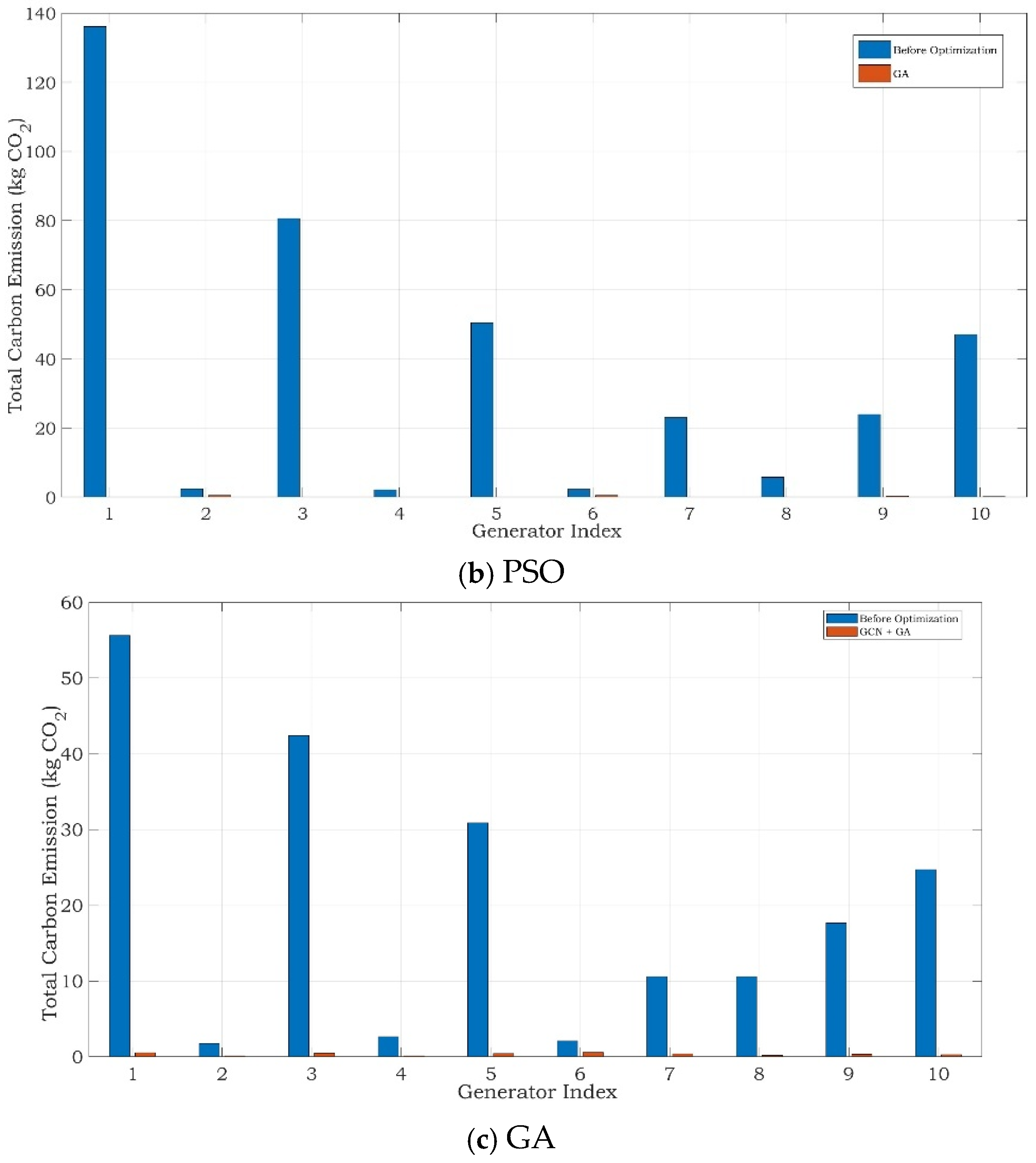
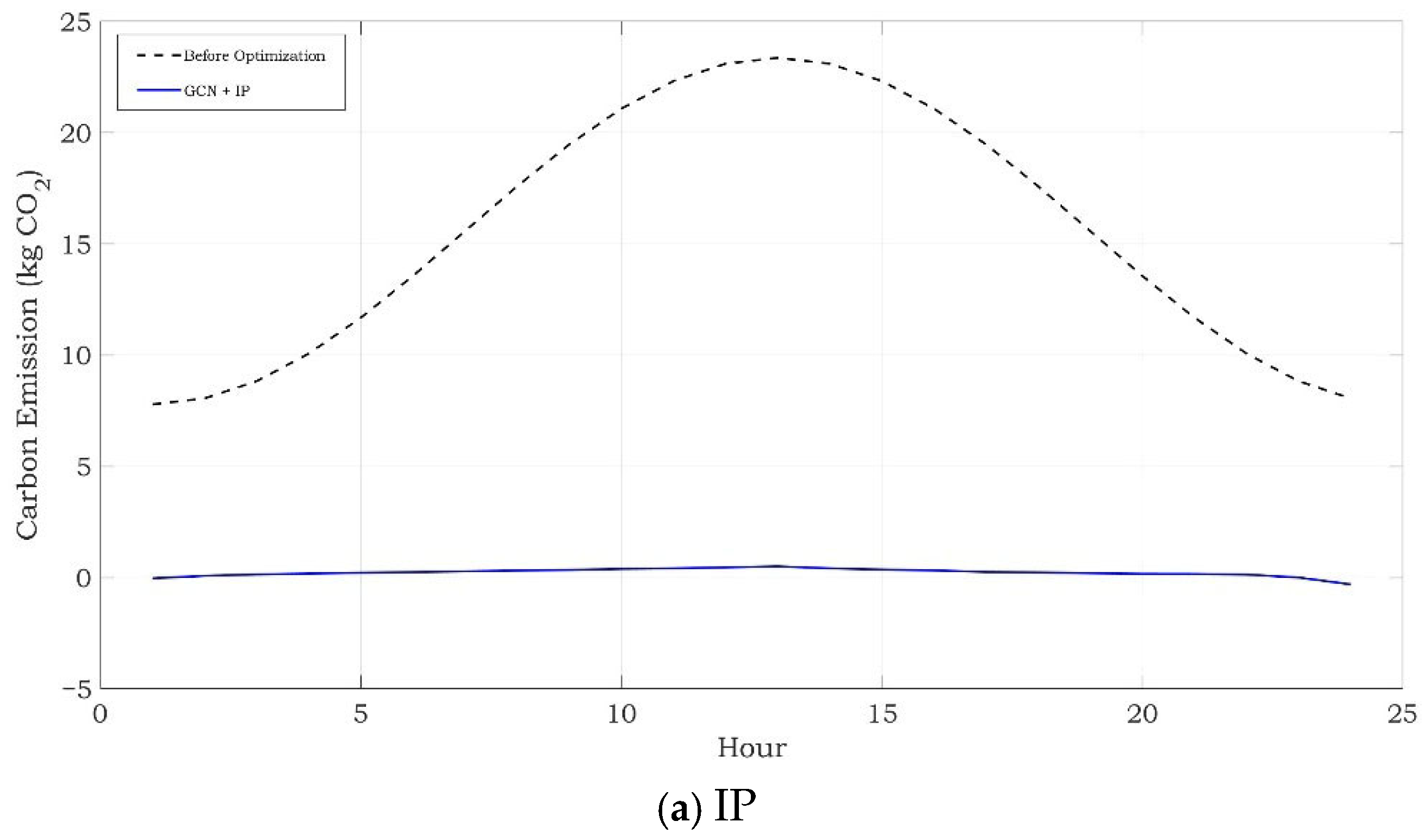
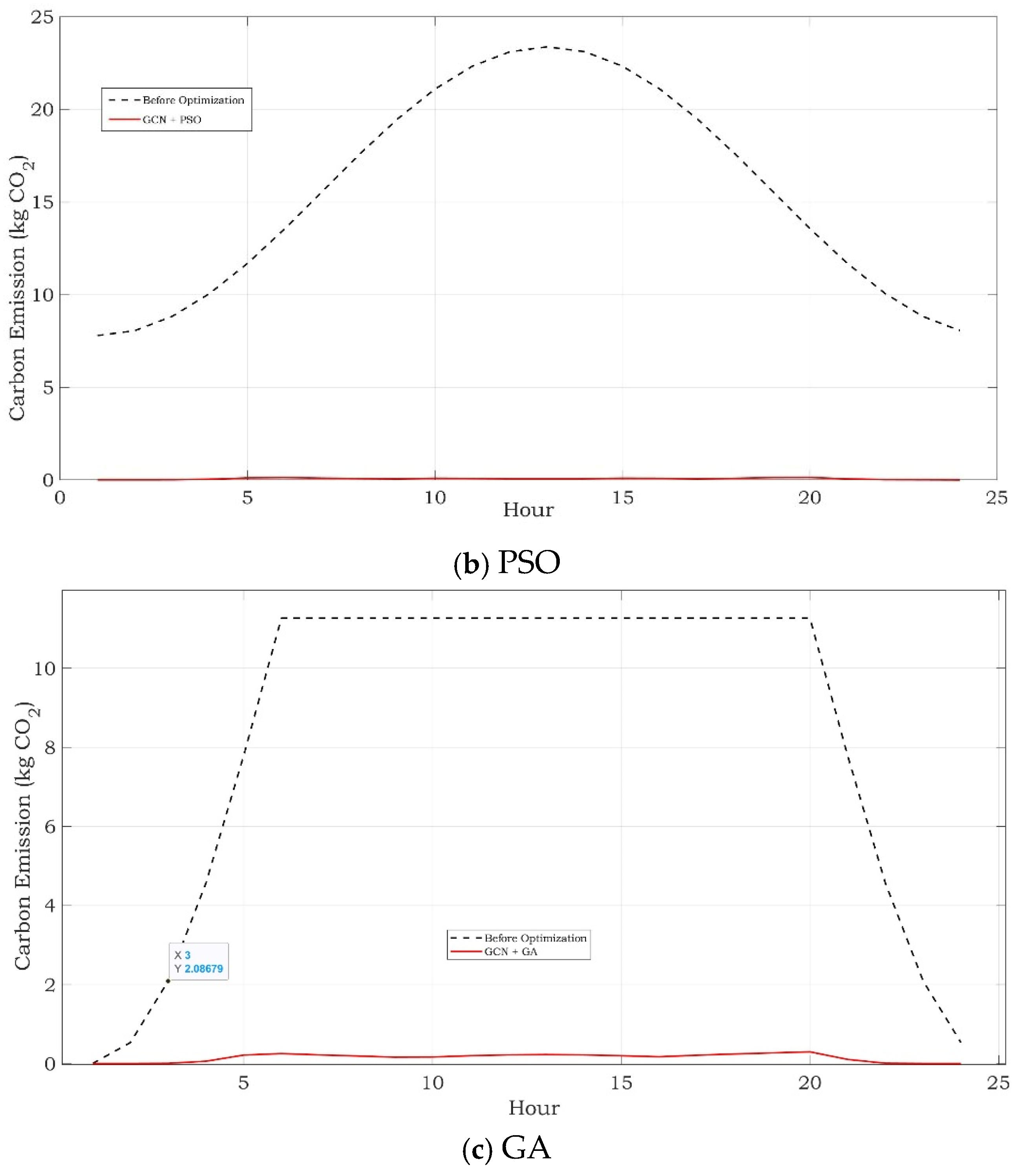
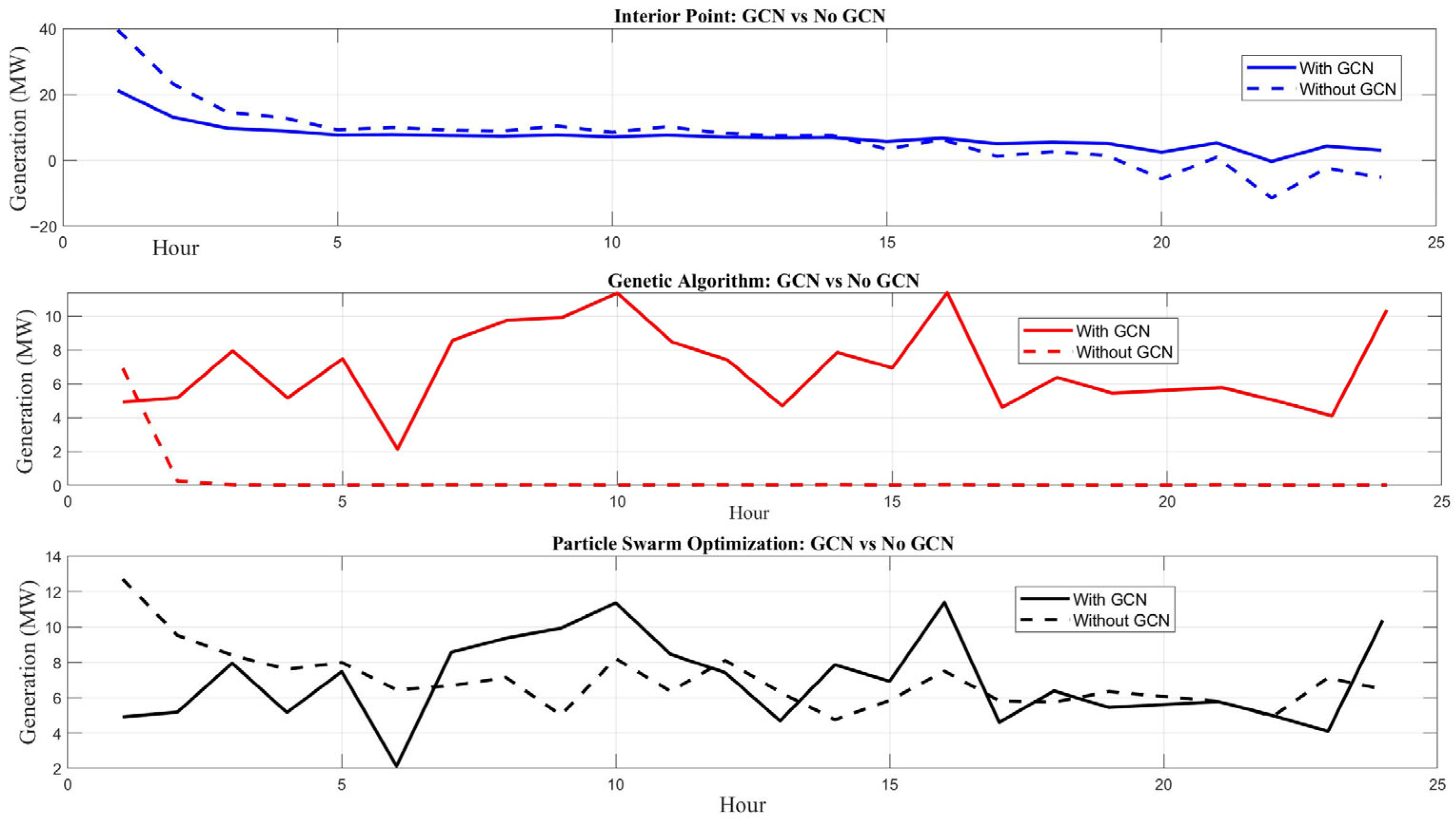
| Model | Spatial Capture | Temporal Horizon | MAPE (%) | Training Complexity |
|---|---|---|---|---|
| Feed-forward ANN (baseline) [42] | None | Short (≤6 h) | ~12 | Low |
| LSTM [40] | Limited spatial | Medium (6–24 h) | ~8 | Medium |
| GAT [43] | Strong | Medium (6–24 h) | ~5 | High |
| Transformer (TFT variant) [44] | Implicit via features | Long (24–72 h) | ~4 | Very High |
| Parameter | Value | Justification |
|---|---|---|
| Emission Factors | 0.7–0.9 kg CO2/MWh (conv.), 0–0.1 (renewables) | [16] |
| Load Profile | 0.55–1.0 p.u. | [13] |
| Wind Variability | 10% standard deviation | [62] |
| Solar Variability | 5% standard deviation | [63] |
| Battery Capacity | 63.74 MWh | [17,18] |
| Voltage Bounds | 0.95–1.05 p.u. | [19] |
| Converter Efficiency | 97% |
| Method | Objective Value | Computation Time (s) | Carbon Emission After Optimization (kg CO2) |
|---|---|---|---|
| GCN-IP | 672.41 | 39.17 | 5.47 |
| GCN-PSO | 11.09 | 119.59 | 1.59 |
| GCN-GA | 4.50 | 4561.27 | 1.76 |
Disclaimer/Publisher’s Note: The statements, opinions and data contained in all publications are solely those of the individual author(s) and contributor(s) and not of MDPI and/or the editor(s). MDPI and/or the editor(s) disclaim responsibility for any injury to people or property resulting from any ideas, methods, instructions or products referred to in the content. |
© 2025 by the authors. Licensee MDPI, Basel, Switzerland. This article is an open access article distributed under the terms and conditions of the Creative Commons Attribution (CC BY) license (https://creativecommons.org/licenses/by/4.0/).
Share and Cite
Otshwe, J.N.; Li, B.; Chabrol, N.J.; Qi, B.; Tshish, L.M. Graph Convolutional-Optimization Framework for Carbon-Conscious Grid Management. Sustainability 2025, 17, 7940. https://doi.org/10.3390/su17177940
Otshwe JN, Li B, Chabrol NJ, Qi B, Tshish LM. Graph Convolutional-Optimization Framework for Carbon-Conscious Grid Management. Sustainability. 2025; 17(17):7940. https://doi.org/10.3390/su17177940
Chicago/Turabian StyleOtshwe, J. N., Bin Li, Ngouokoua J. Chabrol, Bing Qi, and Loris M. Tshish. 2025. "Graph Convolutional-Optimization Framework for Carbon-Conscious Grid Management" Sustainability 17, no. 17: 7940. https://doi.org/10.3390/su17177940
APA StyleOtshwe, J. N., Li, B., Chabrol, N. J., Qi, B., & Tshish, L. M. (2025). Graph Convolutional-Optimization Framework for Carbon-Conscious Grid Management. Sustainability, 17(17), 7940. https://doi.org/10.3390/su17177940







